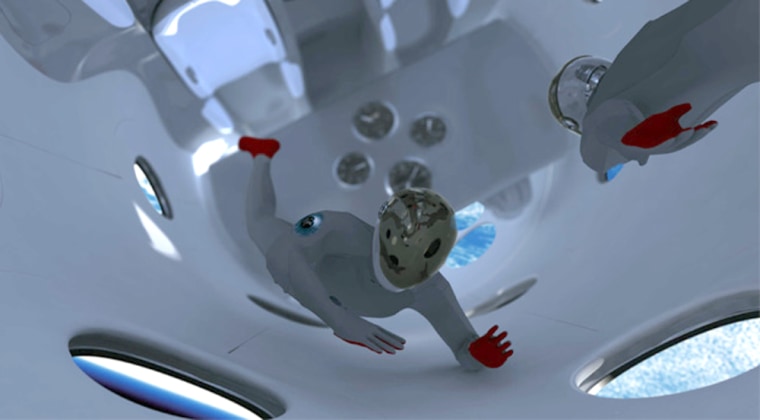Future passengers aboard Virgin Galactic spaceliners can look forward to cushioned reclining seats and lots of windows during suborbital flights aboard SpaceShipTwo, a concept interior of which was unveiled by British entrepreneur Richard Branson Thursday.
“It won’t be much different than this,” Branson told reporters here at Wired Magazine’s NextFest forum. “It’s strange to think that in 12 months we’ll be unveiling the actual plane, and then test flights will commence right after that.”
Virgin Galactic’s spaceliners will be specially outfitted SpaceShipTwo vehicles built by Mojave, California-based Scaled Composites and veteran aerospace designer Burt Rutan. The new spacecraft, designed specifically for space tourism, will be three times the size of Rutan’s SpaceShipOne, which won the $10 million Ansari X Prize for privately developed piloted spacecraft capable of reaching suborbital space twice in two weeks.
The air-launched SpaceShipTwo is designed to seat eight people — six passengers and two pilots — and be hauled into launch position by WhiteKnightTwo, a massive carrier craft currently under construction by Scaled Composites, Virgin Galactic president Will Whitehorn said.
For an initial ticket price of $200,000, Virgin Galactic passengers will buy a 2.5-hour flight aboard SpaceShipTwo and launch from an altitude of about 60,000 feet (18,288 meters), while buckled safely in seats that recline flat after reaching suborbital space. A flight animation depicted passengers clad in their own personal spacesuits as they reached a maximum altitude of at least 68 miles (110 kilometers).
While the spacesuit designs are not yet final, they will likely be equipped with personal data and image recorders to add to SpaceShipTwo’s in-cabin cameras, Whitehorn said.
“If it was ready next week, I’d be there,” Alan Watts, who has traded in 2 million Virgin Atlantic frequent flyer miles for a ride on SpaceShipTwo, told Space.com. “I’m really looking forward to it.”
Branson’s Virgin Galactic spaceliners are slated to roll out and begin test flights by early 2008 in Mojave, with future operational spaceflights to be staged from New Mexico’s Spaceport America beginning in 2009.
“SpaceShipTwo is obviously designed as a commercial vehicle,” Whitehorn said, adding that the vehicle will have a double-skinned hull as added safety for the passengers and pilots inside its pressurized cabin.
Passengers will have several minutes of weightlessness during the spaceflight, and then have about 40 seconds to return to their seats, Whitehorn said, adding that the floor of SpaceShipTwo is also designed to be used during landing if space fliers fail to reach their spots in time.
The WhiteKnightTwo carrier vehicle – which will be larger than a Boeing 757 jet — will sport the same interior as SpaceShipTwo, and will be used for to help train passengers during a three-day orientation period before launch, Virgin Galactic officials said.
Stephen Attenborough, chief of astronaut relations for Virgin Galactic, told Space.com that having two SpaceShipTwo pilots not only allows for redundancy, but frees one pilot to handle any passenger emergencies or issues that pop up during flight.
Whitehorn and Branson both said that SpaceShipTwo will rely on a new type of hybrid rocket fuel, one slightly different from the rubber and nitrous oxide mixture that propelled SpaceShipOne into suborbital space three times in 2004.
The WhiteKnightTwo will also rely on new, cleaner-burning jet engines and bear a close resemblance to the Virgin GlobalFlyer aircraft, which was also built by Rutan’s Scaled Composites and flew around the world without refueling in 2005.
“If you’re going to build a spaceship, you’ve got to build a green spaceship,” Branson said, adding that the carbon dioxide output from a single spaceflight is on par with that attributed to a business-class seat aboard commercial aircraft.
